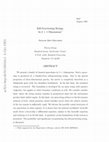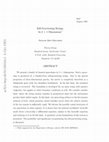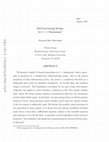Papers by Shahar Ben-Menahem

Nuclear Physics B, Feb 1, 1993
The D = 0 matrix model is reformulated as a nonlocal quantum field theory in two dimensions, in w... more The D = 0 matrix model is reformulated as a nonlocal quantum field theory in two dimensions, in which the interactions occur on the one-dimensional line of hermitian matrix eigenvalues. The field can be thought of as a fluctuation in the potential V , and is conjugate to the density of matrix eigenvalues which appears in the Jevicki collective field theory. The classical solution of the field equation is either unique or labeled by a discrete index. Such a solution corresponds to the Dyson sea modified by an entropy term. The modification smoothes the sea edges, and interpolates between different eigenvalue bands for multiple-well potentials. Our classical eigenvalue density contains nonplanar effects, and satisfies a local nonlinear Schrödinger equation with similarities to the Marinari-Parisi D = 1 reformulation. The quantum fluctuations about a classical solution are computable, and the IR and UV divergences are manifestly removed to all orders. The quantum corrections greatly simplify in the double scaling limit, and include both string-perturbative and nonperturbative effects. The latter are unambiguous for V bounded from below, and can be compared with the various nonperturbative definitions of these theories proposed in the literature.

We report on a physics-based suite of machine-learning algorithms which performs online, real-tim... more We report on a physics-based suite of machine-learning algorithms which performs online, real-time photovoltaic-array incipient hot-spot diagnostics and prognostics, using as input panel-string electrical sensor data. These data consist of module-string currents and voltages and their instantaneous (filtered) rates of change, acquired via a combination of analog and digital sensors. Our diagnostics algorithms comprise thermal and electrical System ID stages, augmented by a Bayesian MAP (Maximum A posteriori Probability) inference engine utilizing a simplified stochastic, spline-based integrated plant model in the optical, electrical and thermal domains. Our (path-integral, physics-based) MAP inference engine detects incipient hot-spots; attributes them to the most likely proximate- and underlying causes (such as shading or dust-deposition patterns, direct heating, inherent mismatches or circuit failures); and renders quantitative estimates of the most likely culpable environmental factor (e.g. a time-varying shading pattern). The same simplified plant model is periodically used to prognosticate the likely future evolution of the incipient hot spot. Our diagnostics and prognostics algorithms can be applied to simulated and/or empirical data (the latter from our roof-top PV lab at Carnegie Mellon). The algorithms leverage changes in estimated conductances in different regions of the electrical state-space, and at different granularities (cells, panels, strings and full array). It take into account temperature coefficients, ohmic- and optical heating, and (optionally) inherent electrical mismatches. Our algorithm suite requires as input neither temperature sensors, nor sub-panel electrical data, nor load sweeps; even pyranometer data is optional. The only necessary sensor data are string electrical data at the actual instantaneous in-operation external load (either with or without a perturb-and-observe MPPT control procedure). Digitized measurements of the low-pass-filtered time derivatives of these currents are useful, but if not available they can be replaced with numerical differentiation. However, occasional voltage sweeps - augmented with pyranometer, thermal and intra-panel (bypass diode voltage) data from our heavily instrumented PV array - along with online astronomical and meteorological data and artificially induced shading patterns - are used to validate our algorithms and to improve the baseline System ID parameters estimation.
Proceedings of SPIE, Apr 27, 2007
The development of advanced signal processing algorithms specifically for Micro/Nano Electro Mech... more The development of advanced signal processing algorithms specifically for Micro/Nano Electro Mechanical Systems (MEMS/NEMS) based sensors has been largely unexplored and can be regarded as the single most important area for improving the performance of these devices. In this paper we present three classes of algorithms that were created to extract weak signals from devices operating in different sensing modalities.
Nucleation and Atmospheric Aerosols, 1995
Journal of Mathematical Physics, May 1, 1986
The motion of a physical system acted upon by external torqueless forces causes the relativistic ... more The motion of a physical system acted upon by external torqueless forces causes the relativistic Thomas precession of the system’s spin vector, relative to an inertial frame. A time-dependent force that returns the system to its initial velocity is considered. The precession accumulates to become a finite rotation of the final spin vector, relative to its initial value. This rotation is commonly explained as the Wigner rotation due to the sequence of pure boosts caused by the force. An alternative interpretation is presented here: The rotation is due to the change of the spin vector as it is parallel-transported around the closed trajectory described by the system in hyperbolic three-velocity space. As an application, the angle of precession for a planar motion is shown to be equal to the area enclosed by the trajectory in velocity space.
Nuclear Physics B, Oct 1, 1991
The critical behavior of the genus-zero two point function in the D = 1 ma-_ trix model is carefu... more The critical behavior of the genus-zero two point function in the D = 1 ma-_ trix model is carefully analyzed for arbitrary embedding-space momentum. It is shown that Kostov's result is valid only for momenta below a (non-universal) cutoff. We extend the large-N WKB treatment to calculate the genus-zero three point function, and elucidate its critical behavior for momenta below the cutoff.

Physical review, May 15, 1993
We present a family of classical spacetimes in 2 + 1 dimensions. Such a spacetime is produced by ... more We present a family of classical spacetimes in 2 + 1 dimensions. Such a spacetime is produced by a Nambu-Goto self-gravitating string. Due to the special properties of three-dimensional gravity, the metric is completely described as a Minkowski space with two identified worldsheets. In the flat limit, the standard string is recovered. The formalism is developed for an open string with massive endpoints, but applies to other boundary conditions as well. We consider another limit, where the string tension vanishes in geometrical units but the end-masses produce finite deficit angles. In this limit, our open string reduces to the free-masses solution of Gott, which possesses closed timelike curves when the relative motion of the two masses is sufficiently rapid. We discuss the possible causal structures of our spacetimes in other regimes. It is shown that the induced worldsheet Liouville mode obeys (classically) a differential equation, similar to the Liouville equation and reducing to it in the flat limit. A quadratic action formulation of this system is presented. The possibility and significance of quantizing the self-gravitating string, is discussed.
Physical review, Jul 15, 1982
A new adiabatic method for improving iterative blocking-truncation approximations in lattice mode... more A new adiabatic method for improving iterative blocking-truncation approximations in lattice models is presented, and applied to a test model. In this approach, the high-frequency (fast) modes are frozen into wave functions that change with the slow modes.

Physics of Plasmas, Nov 1, 1994
Properties of the diocotron instability in a relativistic sheet electron beam propagating through... more Properties of the diocotron instability in a relativistic sheet electron beam propagating through a rectangular conducting wall are investigated within the framework of a macroscopic cold fluid model. The electron beam is assumed to be partially neutralized by the positive immobile ions with the fractional charge neutralization f. The eigenvalue equation is obtained for low-frequency perturbations in standing waves. The dispersion relation of the diocotron instability is derived and used to investigate stability properties for a broad range of system parameters including the ratio a/d of the beam thickness (2a) to the conductor gap (2d) and the charge neutralization f. The dispersion relation indicates that the system is stabilized by increasing the neutralization f to 1/γ2b, where γb is the characteristic value of the beam relativistic factor. It is also shown that the diocotron perturbations are completely stabilized by increasing the beam thickness to more than one-half the conductor gap (i.e., a/d≳0.5) for f=0. The growth rate of instability is a substantial fraction of the diocotron frequency if the system is unstable.
Physical review, Oct 15, 1979
A comparison is made between several models of lattice QED, in 2+1 dimensions, which have been sh... more A comparison is made between several models of lattice QED, in 2+1 dimensions, which have been shown to exhibit confinement for small couplings. We also compare two different approaches which have been employed to study this phenomenon: the variational and path integral methods. The reasons for differences in the results are explored.
Physical review, Feb 1, 1989
We address the problem of choosing an initial state and final measurement that enable maximal ret... more We address the problem of choosing an initial state and final measurement that enable maximal retrodiction of the result of an unknown intermediate spin measurement of a spin-(1/2 particle, along any one of a given set of directions. Details are given of the derivation of the most general possible solution of the problem, which we reported recently. The maximal retrodiction is shown to be the determination of the result of the intermediate spin measurement, along any of four different directions that span three-dimensional space and satisfy a specific linear relation.

Tables I-III. 1U Fart III: Real Space Methods for the XY Model Part IV: Transfer Matrix Methods f... more Tables I-III. 1U Fart III: Real Space Methods for the XY Model Part IV: Transfer Matrix Methods for the Ising Chain in a Transverse Magnetic Field and members of the SLAC theory &roup for useful discussions •-especially Marvin Welnstein, who sugger.te-d the idea for the second part of the thesis. Many thanks to Jacqueline A. llahn, who typed the first manuscript. Finally, special thanks art-due to my family, and In particular to my father, mother and sister for their loving support Erum the very earliest stages of my unusual education to the present day. DISCLAIMER This report was prepared as an account of work sponsored by an agency of the United Stalin Govemncnt. Neither trie United States Government nor any agency thcrwf, nor iiny of their employees, makes any warranty, express or implied, or assumes any legal liability or responsi bility for the accuracy, complctene&s, or usefuln«*«v of any information, apparatus, product, or process disclosed, or represents that its use would not infringe privately owned rights. Refer ence hcreir. to any specific commercial product, process, or service by trade name, trademark, manufacturer, or otherwise does not necessarily constitute or imply its endorsement, recom mendation, or favoring by the United Sta.-S Government or any agency thereof The view* and opinions of authors expressed herein do not neccssjr'k Male 'jr reflect those of the United States Government or any agency thereof.

We present a family of classical spacetimes in 2 + 1 dimensions. Such a spacetime is produced by ... more We present a family of classical spacetimes in 2 + 1 dimensions. Such a spacetime is produced by a Nambu-Goto self-gravitating string. Due to the special properties of three-dimensional gravity, the metric is completely described as a Minkowski space with two identified worldsheets. In the flat limit, the standard string is recovered. The formalism is developed for an open string with massive endpoints, but applies to other boundary conditions as well. We consider another limit, where the string tension vanishes in geometrical units but the end-masses produce finite deficit angles. In this limit, our open string reduces to the free-masses solution of Gott, which possesses closed timelike curves when the relative motion of the two masses is sufficiently rapid. We discuss the possible causal structures of our spacetimes in other regimes. It is shown that the induced worldsheet Liouville mode obeys (classically) a differential equation, similar to the Liouville equation and reducing to...
A new adiabatic method for improving iterative blocking-truncation approximations in lattice mode... more A new adiabatic method for improving iterative blocking-truncation approximations in lattice models is presented, and applied to a test model. In this approach, the high-frequency (fast) modes are frozen into wave functions that change with the slow modes. (Submitted to Physical Review D) Work supported by the Department of Energy, contract DE-AC03-76SF00515.-2-
Alice strings are cosmic strings that turn matter into antimatter. Although they arise naturally ... more Alice strings are cosmic strings that turn matter into antimatter. Although they arise naturally in many GUT’s, it has long been believed that because of the monopole problem they can have no cosmological effects. We show this conclusion to be false; by using the Langacker-Pi mechanism, monopoles can in fact be annihilated while Alice strings are left intact. This opens up the possibility that they can after all contribute to cosmology, and we mention some particularly important examples.
There exists a class of cosmic strings that turn matter into antimatter (Alice strings). In a GUT... more There exists a class of cosmic strings that turn matter into antimatter (Alice strings). In a GUT where the unbroken gauge group contains charge conjugation (C), such strings form when a phase transition renders C a discrete symmetry. They become boundaries of domain walls at a later, C-breaking transition. These ‘Alice walls ’ are cosmologically harmless, but can play an important role in baryogenesis. We present a three-generation toy model with scalar baryons, where a quasi-static Alice wall (or a gas of such walls) temporarily gives rise to net baryogenesis of uniform sign everywhere in space. This becomes a permanent baryon excess if the wall shrinks away early enough. We comment on the possible relevance of a similar mechanism to baryogenesis in a realistic SO(10) unification model, where Alice walls would form at the scale of left-right symmetry breaking.
Proceedings of the 17th IFAC World Congress, 2008, 2008
Neural network based control of a serial-link robotic manipulator is considered subject to a sign... more Neural network based control of a serial-link robotic manipulator is considered subject to a signal dependent noise (SDN) model corrupting the training signal. A radial basis function (RBF) network is utilized in the feedforward control to approximate the unknown inverse dynamics. The weights are adaptively adjusted according to a gradient descent plus a regulation term (Narendra's e-modification). A typical quadratic stochastic Lyapunov function is constructed which shows under certain noise models it is not necessary to employ quartic Lyapunov functions as is typically carried out in stochastic adaptive backstepping designs. Bounds on the feedback gains, and learning rate parameters are derived that guarantee the origin of the closed loop system is semi-globally, uniformly bounded in expectation (SGUBE).

We present a family of classical spacetimes in 2+1 dimensions. Such a spacetime is produced by a ... more We present a family of classical spacetimes in 2+1 dimensions. Such a spacetime is produced by a Nambu-Goto self-gravitating string. Due to the special properties of three-dimensional gravity, the metric is completely described as a Minkowski space with two identified worldsheets. In the flat limit, the standard string is recovered. The formalism is developed for an open string with massive endpoints, but applies to other boundary conditions as well. We consider another limit, where the string tension vanishes in geometrical units but the end-masses produce finite deficit angles. In this limit, our open string reduces to the free-masses solution of Gott, which possesses closed timelike curves when the relative motion of the two masses is sufficiently rapid. We discuss the possible causal structures of our spacetimes in other regimes. It is shown that the induced worldsheet Liouville mode obeys ( classically) a differential equation, similar to the Liouville equation and reducing to ...

Uploads
Papers by Shahar Ben-Menahem